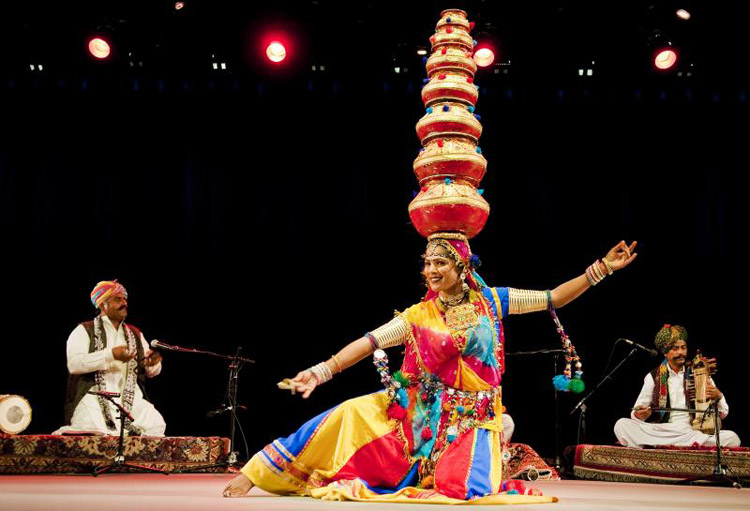 Marwari (Marwadi)—the South Asian multi-linguistic group, particularly in India and Nepal—is an umbrella term that includes both Hindus and Jains who have originated from the eastern Rajasthan region, i.e. Marwar of India. The rich language of this community, Marwari, is included under the umbrella of Rajasthani languages, and is said to originate from the three important regions of Rajasthan: Marwar, Mewar, and Shekhavati. Typically known for their highly successful business acumen and as inland traders during the era of Rajput kingdoms, today, they are recognized for their association with commerce and their strong network in trading activities. Apart from their achievements in the area of business enterprise, the Marwari community has also earned a reputation for their rich heritage, culture, and tradition. Their connection with their roots, close bonds with family, and wonderful folk songs and dances reflect the courage of their rulers and the artistic beauty related with the land. Marwaris have a historical background in Nepal, right from the era of King Prithivi Narayan Shah.
Marwari (Marwadi)—the South Asian multi-linguistic group, particularly in India and Nepal—is an umbrella term that includes both Hindus and Jains who have originated from the eastern Rajasthan region, i.e. Marwar of India. The rich language of this community, Marwari, is included under the umbrella of Rajasthani languages, and is said to originate from the three important regions of Rajasthan: Marwar, Mewar, and Shekhavati. Typically known for their highly successful business acumen and as inland traders during the era of Rajput kingdoms, today, they are recognized for their association with commerce and their strong network in trading activities. Apart from their achievements in the area of business enterprise, the Marwari community has also earned a reputation for their rich heritage, culture, and tradition. Their connection with their roots, close bonds with family, and wonderful folk songs and dances reflect the courage of their rulers and the artistic beauty related with the land. Marwaris have a historical background in Nepal, right from the era of King Prithivi Narayan Shah.
With such ancient history and culture behind it, Jhapa Marwari Samaj proudly organized the first Marwari Mahotsav 2018 in Nepal on April 28, 2018, at Bhrikutimandap, Kathmandu. Its aim was to showcase Marwari culture and tradition, solely with the objective of raising awareness and knowledge about its history, culture, and traditions. The main objective was to create solidarity among the community members and to continue celebrating the day as an annual cultural event. Apart from this, the idea was also an effort to make the Marwari language recognized as one of the national languages.
With the combined effort of organizations like Jhapa Marwari Samaj, Marwari Yuwa Manch, Nepal Marwari Brahmin Sewa Sanga, Sunsari Marwari Samaj, Pashupati Marwari Sewa Sanga, Marwari Sewa Samiti Nepal, Nepal Rastriya Marwari Parishad, Nepal Maheswari Parishad, Agrawal Sewa Kendra, and Nepal Jain Parishad, the event kicked off at 10:00 a.m. with a rally from Kamladi Ganesthan. The participants carried banners with quotes related to Marwari culture and headed towards Bhrikutimandap, where the event was officially inaugurated by the Speaker of the House of Representative of Nepal, Shri Krishna Bahadur Mahara, and the Ambassador of India to Nepal, Shri Manjeev Singh Puri. The event began with a welcome dance, followed by an award ceremony, where five personalities from the Marwari community were recognized for their excellent contribution in their respective fields of work. The names included Mr. Binod Chaudhary (industry), Dr. Jagdish Agrawal (service), Laxman Newatia (literature), Dinbhandhu Goyal (social work), and Om Prakash Sarawagi (politics).
A documentary was shown regarding the history and contribution of Marwaris in Nepal. One of the important aspects included in the documentary that really amazed me was about the establishment of Marwari Vidyalaya in 1959 for the growth of culture and language in Nepal which was later shut down due to land dispute. The folk dance by the professional dance group of 35 artists from Jaipur took me to the Rajasthan region of India and made me feel the vibes of that place. I remember enjoying those dances when I last went to Rajasthan a year back. The dances included chari dance, with fire pot, bhawai dance, graminbhawai, kalbelya, ghoomer, gorband, kachhighodi, and mouth fire dance. The folk dances would remain incomplete without the folk music performed by the musical troupe on instruments like sarangi, rawanhattha, kamayacha, morchang, and ektara, which was quite soothing and left everyone amazed at the skills of the musicians.
One of the most interesting parts of the event was the puppet show, which I really appreciated. Famous as kathputli, it’s one of the ancient art forms that has become an eternal part of Rajasthani culture. Other activities at the event included a photo booth where people could go and get a photo clicked wearing Rajasthani dress; mehendi stall; a stall with the banner, Tabar Ro Khel, i.e. kids’ corner; lakharan, for the ladies, where they made their bangles on the spot; and kumhar, demonstrating clay artistry, where clay utensils were offered to the spectators.
Apart from all these, my personal favorite was the free food stalls that offered typical Marwari food that I guess are only available in Rajasthan in India. The food included mathe baajra, raabdi, baajra ri roti, chaah, and other items. This event literally took me back to those Rajasthan days, where the hot scorching heat and these cool food items were like heaven to us. These sorts of events are very important, so that the Marwari people can come together and celebrate their tradition with pride. I hope I get similar opportunities to attend similar programs in the future, so that I gather more information about my culture and also make others aware about it.











